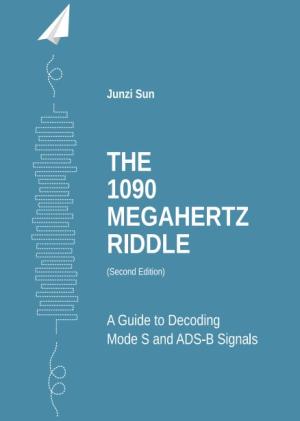The 1090 Megahertz Riddle: A Guide to Decoding Mode S and ADS-B Signals
Keywords:
Aircraft Surveillance, Decoding, Mode S, ADS-B, Open data, pyModeSSynopsis
In the last twenty years, aircraft surveillance has moved from controller-based interrogation to automatic broadcast. The Automatic Dependent Surveillance-Broadcast (ADS-B) is one of the most common methods for aircraft to report their state information like identity, position, and speed. Like other Mode S communications, ADS-B makes use of the 1090 megahertz transponder to transmit data. The protocol for ADS-B is open, and low-cost receivers can easily be used to intercept its signals. Many recent air transportation studies have benefited from this open data source. However, the current literature does not offer a systematic exploration of Mode S and ADS-B data, nor does it explain the decoding process.
This book tackles this missing area in the literature. It offers researchers, engineers, and enthusiasts a clear guide to understanding and making use of open ADS-B and Mode S data. The first part of this book presents the knowledge required to get started with decoding these signals. It includes background information on primary radar, secondary radar, Mode A/C, Mode S, and ADS-B, as well as the hardware and software setups necessary to gather radio signals. After that, the 17 core chapters of the book investigate the details of all types of ADS-B signals and commonly used Mode S signals. Throughout these chapters, examples and sample Python code are used extensively to explain and demonstrate the decoding process. Finally, the last chapter of the book offers a summary and a brief overview of research topics that go beyond the decoding of these signals.
Downloads
References
Blythe, W., Anderson, H., and King, N.Ads-b implementation and operations guidance document. International Civil Aviation Organization, 2011.
Carlitz, L. "The arithmetic of polynomials in a Galois field". In: American Journal of Mathematics54.1 (1932), pp. 39-50. https://doi.org/10.2307/2371075
Chomik, G. "The future of collision avoidance-ACAS X". In: International Journal of Engineering Trends and Technology39.5 (2016), pp. 284-287. https://doi.org/10.14445/22315381/IJETT-V39P247
Chulliat, A., Macmillan, S., Alken, P., Beggan, C., Nair, M., Hamilton, B., Woods, A., Ridley, V., Maus, S., and Thomson, A. "The US/UK world magnetic model for 2015-2020". In: (2015). http://dx.doi.org/10.7289/V5TB14V7
Doran, R. W. "The Gray Code". In: Journal of Universal Computer Science13.11 (2007),pp. 1573-1597. https://doi.org/10.3217/jucs-013-11-1573
Gertz, J. L. Fundamentals of mode s parity coding. Tech. rep. Massachusetts Institute of Technology, Lincoln Laboratory, 1984.
Grami, A. Introduction to Digital Communications. Academic Press, 2015. Chap. 10: Error-Control Coding. https://doi.org/10.1016/B978-0-12-407682-2.00001-6
Grappel, R. D., Harris, G. S., Kozar, M. J., and Wiken, R. T. "Elementary Surveillance (ELS) and Enhanced Surveillance (EHS) Validation via Mode S Secondary Radar Surveillance". In: Project Report ATC-337, Lincoln Lab., MIT(2008). https://doi.org/10.21236/ADA489387
Gray, D. E. and Barrett, C. W. Privacy Impact Assessment (PIA) - Federal Aviation Administration (FAA) Privacy ICAO Address System. U.S. Department of Transportation,2019.
ICAO. Annex 10 to the Convention on International Civil Aviation, Aeronautical Telecommunications. International Civil Aviation Organization, 2002.
ICAO.Manual on Mode S Specific Services, 2nd Edition. Tech. rep. Doc 9688, AN/952.2004.
ICAO. Secondary Surveillance Radar Mode S Advisory Circular. International Civil Aviation Organization, 1983.
ICAO.Technical Provisions for Mode S Services and Extended Squitter. International Civil Aviation Organization, 2008.
Kasami, T. and Matoba, S. "Some efficient shortened cyclic codes for burst-error correction (Corresp.)" In: IEEE Transactions on Information Theory 10.3 (1964), pp. 252-253. https://doi.org/10.1109/TIT.1964.1053665
Kaune, R., Steffes, C., Rau, S., Konle, W., and Pagel, J. "Wide area multilateration using ADS-B transponder signals". In: Information Fusion (FUSION), 2012 15th International Conference on. IEEE. 2012, pp. 727-734. https://doi.org/10.1109/SDF.2012.6327913
Mandel, T. and Mache, J. "Investigating CRC Polynomials that Correct Burst Errors." In: ICWN. 2009, pp. 632-637.
Mazda, F. Telecommunications engineer's reference book. Butterworth-Heinemann,2014.
Noschese, P., Porfili, S., and Di Girolamo, S. "Ads-b via iridium next satellites". In: Digital Communications-Enhanced Surveillance of Aircraft and Vehicles (TIWDC/ESAV),2011 Tyrrhenian International Workshop on. IEEE. 2011, pp. 213-218.
Olive, X. "traffic, a toolbox for processing and analysing air traffic data". In:Journalof Open Source Software4.39 (2019), p. 1518. https://doi.org/10.21105/joss.01518
Orlando, V. A. "The mode S beacon radar system". In: The Lincoln Laboratory Journal 2.3 (1989), pp. 345-362.
RTCA. "Minimum operational performance standards for 1090MHz extended squitter automatic dependent surveillance-broadcast (ADS-B) and traffic information services-broadcast (TIS-B)[J]". In: RTCA DO-260B 1.1 (2011), pp. 1365-1372.
RTCA. "Minimum Operational Performance Standards for Universal Access Transceiver (UAT) automatic dependent surveillance-broadcast". In: RTCA DO-282A (2002).
Schäfer, M., Strohmeier, M., Lenders, V., Martinovic, I., and Wilhelm, M. "Bringing up OpenSky: A large-scale ADS-B sensor network for research". In:IPSN-14 Proceedings of the 13th International Symposium on Information Processing in Sensor Networks. IEEE.2014, pp. 83-94. https://doi.org/10.1109/IPSN.2014.6846743
Sun, J. and Hoekstra, J. "Analyzing Aircraft Surveillance Signal Quality at the 1090 Megahertz Radio Frequency". In: Proceedings of the 9th International Conference for Research in Air Transportation. 2020.
Sun, J. and Hoekstra, J. "Integrating pyModeS and OpenSky Historical Database". In: Proceedings of the 7th OpenSky Workshop 2019. Vol. 67. 2019 https://doi.org/10.29007/mmsb
Sun, J., Vû, H., Ellerbroek, J., and Hoekstra, J. M. "pymodes: Decoding Mode S Surveillance Data for Open Air Transportation Research". In: IEEE Transactions on Intelligent Transportation Systems(2019) https://doi.org/10.1109/TITS.2019.2914770
Young, T. M. Performance of the Jet Transport Airplane: Analysis Methods, Flight Operations, and Regulations. John Wiley & Sons, 2017. https://doi.org/10.1002/9781118534786

Published
Categories
License

This work is licensed under a Creative Commons Attribution-NonCommercial-ShareAlike 4.0 International License.



